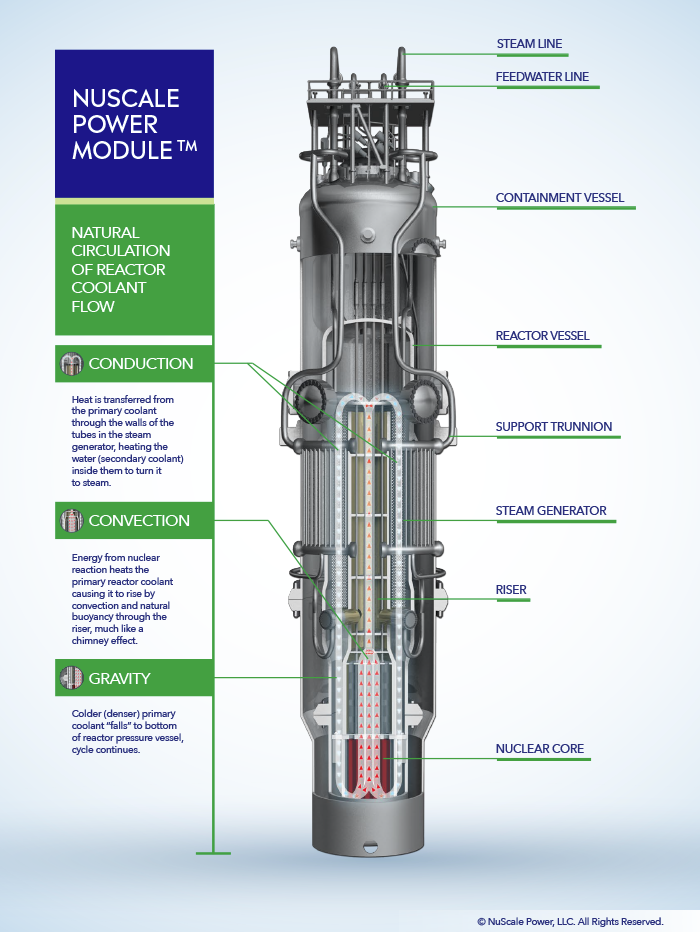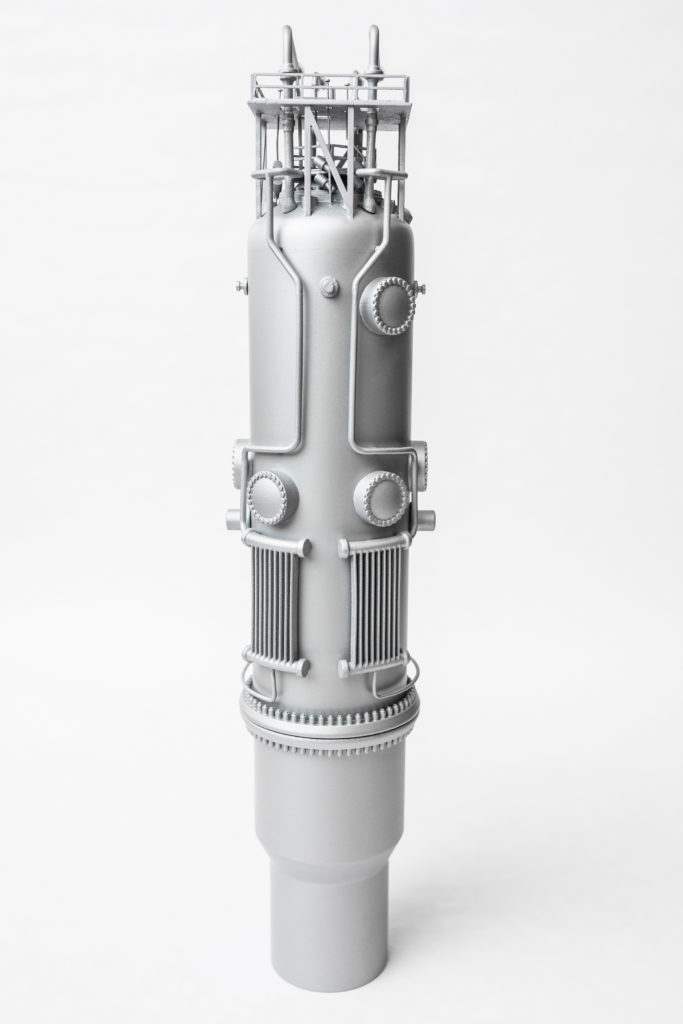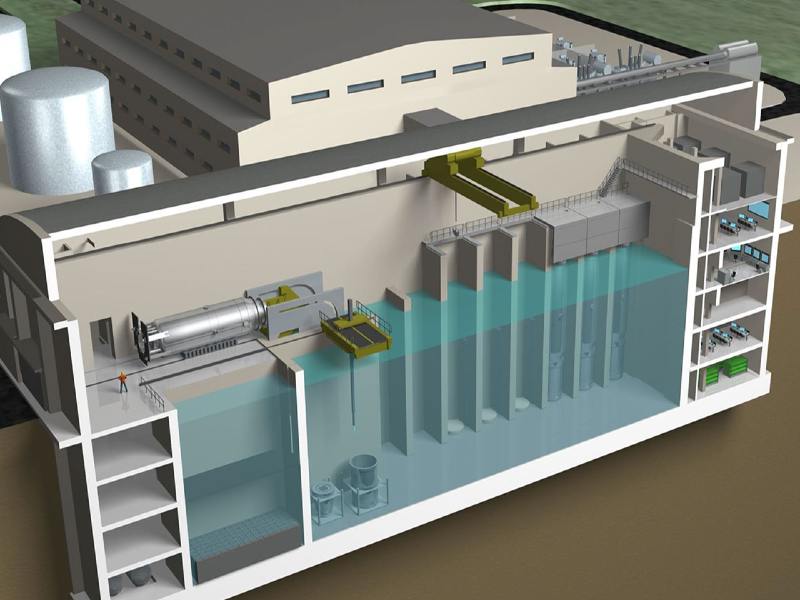Small modular reactors could be the future of clean energy. Small modular reactors, SMR for short, are more compact versions of your typical nuclear reactor. Today’s nuclear reactors are contained within massive faculties with towering steam towers, but SMRs are just a fraction of the size and will be contained in smaller buildings. NuScale is a company that is currently in the process of sending its SMR design through the regulatory process. NuScale proposes that their SMRs will be better in terms of cost and safety in comparison to the large nuclear reactors currently in operation. SMRs offer lots of improvements over the nuclear reactors that are running today and could very well be the future of clean energy.
NuScale’s SMR is an iPWR (integral pressurized water reactor). iPWRs use regular water under high pressure. Allowing the water to stay liquid at very high temperatures. The integral part means all the main components of the reactor are contained within a single pressure vessel. This creates a small and concentrated power source. NuScale reactors can produce 77 MWe [1]. This may seem like a small amount of electricity, but NuScale allows multiple reactors to be combined into a single system. NuScale allows up to 12 reactors integrated into a system, giving the system a 924 MWe output [1]. One of the units at the Limerick Generation Station produces just over 1000 MWe [2]. Being able to combine multiple SMRs depending on the client’s needs makes NuScale’s product a very versatile power source.

NuScale Power Module – Photo by NuScale Power

Photo by Business Wire
The construction cost for NuScale’s SMRs is expected to be significantly lower than that of already constructed nuclear power plants. Unit 1 of the Limerick nuclear power plant cost $7.246 billion [2]. NuScale proposes that a 12 pack of their reactors along with all other construction costs will be $2.469 billion [3]. NuScale will be able to construct a power plant at one-third of the cost with almost the same power outage. The construction length for the entire NuScale power plant is expected to take less than 36 months [3]. The average construction length for a nuclear power plant is 7.5 years. This allows labor costs to be significantly less. The emergency planning zone (EPZ) is the area surrounding a nuclear power plant in the case of an accident. Typical reactors have an EPZ of 10 miles in radius. NuScale has an EPZ of 40 acres which is about 3.5 miles in radius [4]. Construction for NuScale’s SMRs costs less, takes less time, and takes up a smaller area compared to the reactors that are running today.
NuScale’s SMRs utilize many passive safety features. Passive safety features are actions that can occur without the use of electricity, and instead uses natural forces. This makes sure that when a bad accident occurs where the control systems do not have electricity, the reactor can still have a method of shutting down safely. The SMRs are located inside a partially underground building. The reactors are also submerged in water. NuScale’s SMRs contain a feature that if too much pressure is starting to build within the reactor, valves will open and release steam to a separate area of the reactor vessel. This separate area can reduce the heat of the steam through convection with the pool of water it is submerged in. The reactors also have control rods that will stop nuclear fission from occurring when released into the reactor core. These control rods hang above the reactor core. When power is lost the control rods automatically fall into the core stopping fissions from continuing. NuScale’s SMRs have adaptable safety features that can still work without the use of electricity, making worse case scenarios a whole lot safer.

Photo from article on Power Engineering International: “Japanese EPC invests $40m in nuclear SMR developer NuScale Power“
NuScale’s SMRs may have plenty of advantages over reactors in operation today, but they still have some downsides when it comes to other power sources. The biggest problem surrounding nuclear reactors, in general, is the disposal of nuclear waste. Many reactors store the spent fuel on-site, and NuScale’s SMRs are no different. Within the reactor building, there is a spent fuel area. This area can hold 10 years of used fuel. This is a very convenient use of the space, but it is not a perfect solution. Another issue is the cost. Compared to large reactors, these SMRs cost almost a third of the price per KW, but it is no comparison to the construction of a natural gas plant. NuScale proposes the cost of construction per kilowatt is $3,600/KW [3] compared to a natural gas plant’s $1,078/KW [5]. This cost difference makes less expensive energy sources like natural gas more enticing than nuclear energy. NuScale’s SMRs have a lot of great advantages but there are still plenty of places that can be improved.
As the United States tries to complete its goal to reduce carbon emissions, NuScale offers a very clean and new approach to nuclear energy. These reactors are smaller, but in packs offer a great amount of power. They utilize many passive safety features that will continue making nuclear power a very safe energy source. These NuScale plants can be built faster, take up less area, and cost a lot less than typical reactors. NuScale’s reactors still face the same problems as all nuclear reactors with their spent fuel and cost of construction compared to other energy sources. Overall, NuScale’s SMRs open a door for clean energy as countries try to cut back on the production of greenhouse gasses.
Citations:
[1]: https://www.nrc.gov/reactors/new-reactors/smr/nuscale-720-sda.html
[2]: https://www.eia.gov/nuclear/state/archive/2010/pennsylvania/
[3]: https://www.nuscalepower.com/benefits/cost-competitive
[4]: https://www.nuscalepower.com/benefits/safety-features/emergency-planning-zone
[5]: https://www.eia.gov/todayinenergy/detail.php?id=31912
Pictures: